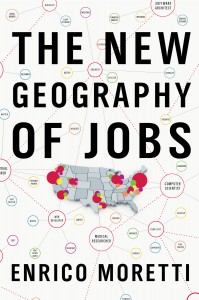Stamford is #1 in USA in Workers with College Degree; Geography Key to Job Prospects
/
Stamford ranks first in the nation in the percentage of workers with a college degree, according to a book that features an analysis of the influences of geography on jobs, highlighting tremendous disparities that exist in cities across the country and citing innovation as a key jobs driver.
“The sheer size of the differences between American communities is staggering," the book stated. " Stamford, Connecticut, the city with the largest percentage of college-educated workers in the United States, has five times the number of college graduates per capita as the city at the bottom, Merced, California.”
The New Geography of Jobs, written by Enrico Moretti, a professor of Economics and the University of California, ranked 306 of the nation’s metropolitan areas. In the ranking, Waterbury was among the metropolitan areas with the smallest share of workers with a college degree, at 15 percent.
Stamford, with 56 percent, led the list, topping Washington, DC (49%), Boston (47%), Madison (47%) and San Jose (47%), which rounded out the top five metropolitan areas in the country. Completing the top 10 metropolitan areas with the largest share of workers with a college degree is Ann Arbor (46%), Raleigh-Durham(44%), San  Francisco-Oakland (44%), Fort Collins-Loveland, Colorado (44%), and Seattle-Everett, Washington (42%). Yuma, AZ and Merced, CA, both at 11 percent, ranked last.
Francisco-Oakland (44%), Fort Collins-Loveland, Colorado (44%), and Seattle-Everett, Washington (42%). Yuma, AZ and Merced, CA, both at 11 percent, ranked last.
Moretti’s research and analysis reveals that the “new geography of jobs is benefitting centers of innovation,” and “among the beneficiaries are the workers who support the idea creators.” He indicates that “for every new innovation job in a city, five additional non-innovation jobs are created, and those workers earn higher salaries than their counterparts in other urban areas.”
According to the book, the average salary of college graduates in Stamford is $133,479 and the average salary of high school graduates is $107,301. Moretti points out that “the more college graduates there are (in a metropolitan area) the higher the salaries for high school graduates are.” Overall, “the earnings of a worker with a high school  education rise by about 7 percent as the share of college graduates in his city increases by 10 percent,” a statistical analysis indicates.
education rise by about 7 percent as the share of college graduates in his city increases by 10 percent,” a statistical analysis indicates.
Morelli also notes that the education level of the workforce not only impact salaries, but also the level of charitable contributions. “Among large U.S. metropolitan areas, charities in five brain hubs – Stamford, Boston, Raleigh-Durham, Washington, D.C., and New York – receive the highest contributions relative to their population.”
The book also ranks Stamford as the metropolitan area with the second highest cost of living in the nation, behind only San Jose, CA, and just ahead of San Francisco-Oakland-Vallejo, California. Also in the top 20 cities with the heist cost of living is Bridgeport, at number 17.
The New Geography of Jobs was published by Houghton Mifflin Harcourt in 2012. Moretti is Professor of Economics at the University of California, Berkeley where he holds the Michael Peevey and Donald Vial Career Development Chair in Labor Economics. He is the Director of the Infrastructure and Urbanization Program at the International Growth Centre (London School of Economics and Oxford University).





























